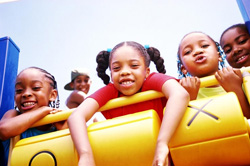Paranoia or Prevention?
My husband is frequently exasperated by my obsession with our kids’ safety. He’s certain I see danger hiding behind every blade of grass. And as a pediatric intensivist, I’ve seen enough bizarre, unlikely, and unlucky childhood injuries to make that fairly true (I’ve got a whole thing about lawn mowers, for example). MomDoc or not, I’m guessing some of you have had similar conversations. And maybe, like us, in the wake of over a year of social distancing and staring out your house windows, you’ve started to think about installing a home pool. Great! Now how do we do that and keep the kids safe? True to my anxious self, I’ve read up on current recommendations, and I’ve talked to dozens of home pool owners. Here is what I’ve learned about pool safety.
The Truth Behind Those Fears
First, my concerns are not unfounded. Drowning is one of the most common causes of traumatic death in children, and hospitalizations for submersion injuries occur at five times the rate of deaths, sometimes with devastating long-term consequences. Children 1-4 years of age are at the highest risk and can drown in as little as two inches of water. Tragically, this is yet another health statistic in which children of color are disproportionately affected. Younger children are more likely to be submerged in bodies of water near to home – inflatable and permanent pools, bathtubs, etc. – but as children get older, their injuries are more likely to occur in natural bodies of water.
When It Comes to Fences Remember Four – Four Feet High on All Four Sides
If you are building a home pool, you may be aware already that one of the most effective safety measures is required: a fence! The American Academy of Pediatrics (AAP) recommends that pool fences be at least 4 feet high and should have self-latching gates for which the latch is out of the reach of small children. I can attest that many of the latches I’ve encountered have the additional safety/humiliation feature of being difficult to figure out how to operate on the first attempt. Or maybe that’s just me. Fences should enclose the pool area on all four sides. Studies have shown that, in comparison to a three-sided fence, four-sided fences reduce drowning risk by 83%.
Supervision is Key!
The AAP also recommends that children be supervised by an adult at all times while swimming or near the pool. Small children (under two years of age) should always be within arm’s reach of an adult. Parents should not place undue confidence in floaties or water wings, as these may not keep a distressed child afloat. The supervising adult should avoid distractions, should not be impaired, should be able to swim, and, ideally, should be trained in CPR. Children should be taught from an early age that swimming without an adult present is not permitted.
When they are older, they should know that they should never swim without a buddy. Swimming lessons are recommended for all children and should start at age four years at the latest; earlier swimming lessons – from ages 1-4 years – may be beneficial. However, they do not reduce the need for immediate adult supervision near water. Toys, pool floats, and games should be removed from around the pool when the pool is not in use and an adult is not present. This will reduce enticements that may draw children toward the pool when an adult is not nearby. Pool covers that are well-fitting and do not have gaps that children can slip beneath may also reduce submersion risk.
Water Safety Outside the Pool
If you are using inflatable home pools or are going to be near natural bodies of water, there are some additional safety precautions to consider. Inflatable pools should be deflated and/or emptied immediately after you are finished using them. Life jackets should be worn any time your child is on a boat or other water vehicle. Children should be taught from an early age about the dangers of diving or jumping into the water when the depth or underlying landscape of the water is unknown.
And Remember… Have Fun!
Summers in St. Louis certainly make the relief of a nice swim extremely appealing. So don’t let fear stop you. Swimming can be a great source of fun and exercise for kids and adults alike. Just remember, a bit of “safety first” thinking can help rather than hinder the fun (please tell my husband)!






Comments